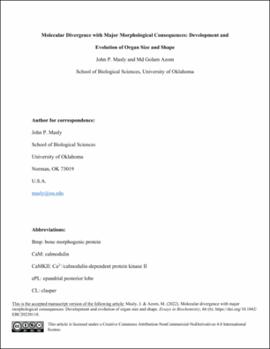| dc.contributor.author | Masly, John P. | |
| dc.contributor.author | Azom, Md Golam | |
| dc.date.accessioned | 2023-06-29T13:42:08Z | |
| dc.date.available | 2023-06-29T13:42:08Z | |
| dc.date.issued | 2022-11 | |
| dc.identifier.citation | Masly, J.P. and Md Golam Azom (2022) Molecular divergence with major morphological consequences: development and evolution of organ size and shape. Essays in Biochemistry EBC20220118. doi:10.1042/EBC20220118. PMID: 36373649 | en_US |
| dc.identifier.uri | https://hdl.handle.net/11244/337842 | |
| dc.description.abstract | Understanding the causes of the morphological diversity among organisms is a topic of great interest to evolutionary developmental biologists. Although developmental biologists have had great success in identifying the developmental mechanisms and molecular processes that specify organ size and shape within species, only relatively recently have the molecular tools become available to study how variation in these mechanisms gives rise to the phenotypic differences that are observed among closely related species. In addition to these technological advances, researchers interested in understanding how molecular variation gives rise to phenotypic variation have used three primary strategies to identify the molecular differences underlying species-specific traits: the candidate gene approach, differential gene expression screens, and between-species genetic mapping experiments. In this review, we discuss how these approaches have been successful in identifying the genes and the cellular mechanisms by which they specify variation in one of the most recognizable examples of the evolution of organ size, the adaptive variation in beak morphology among Darwin’s finches. We also discuss insect reproductive structures as a model with great potential to advance our understanding of the specification and evolution of organ size and shape differences among species. The results from these two examples, and those from other species, show that species-specific variation in organ size and shape typically evolves via changes in the timing, location, and amount of gene/protein expression that act on tissue growth processes. | en_US |
| dc.language | en_US | en_US |
| dc.rights | Attribution-NonCommercial-NoDerivatives 4.0 International | * |
| dc.rights.uri | https://creativecommons.org/licenses/by-nc-nd/4.0/ | * |
| dc.subject | gene expression | en_US |
| dc.subject | molecular evolution | en_US |
| dc.subject | morphology | en_US |
| dc.subject | developmental biology | en_US |
| dc.subject | species variation | en_US |
| dc.title | Molecular Divergence with Major Morphological Consequences: Development and Evolution of Organ Size and Shape | en_US |
| dc.type | Article | en_US |
| dc.description.peerreview | Yes | en_US |
| dc.identifier.doi | 10.1042/EBC20220118 | en_US |
| ou.group | Dodge Family College of Arts and Sciences::Department of Biology | en_US |
| dc.description.notes | This is the accepted manuscript version of the following article: Masly, J. & Azom, M. (2022). Molecular divergence with major morphological consequences: Development and evolution of organ size and shape. Essays in Biochemistry, 66 (6). https://doi.org/10.1042/EBC20220118. | |

